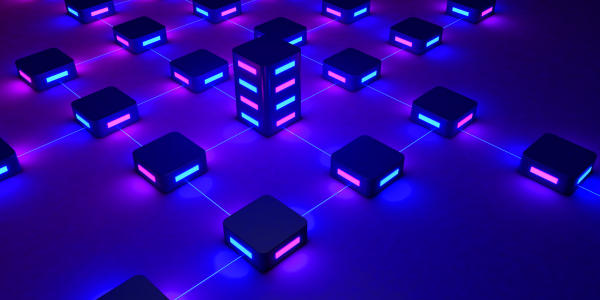If you’re unfamiliar with blockchain nodes, this is where we’ll talk about their role in the crypto world.
You’ll also learn what a node is in cryptocurrency, about the different types of nodes, as well as the requirements you’ll need to meet to run them.
What Is a Blockchain Node?
Crypto nodes are one of the four main components of the blockchain ecosystem. They are intermediaries for the creation and maintenance of decentralized infrastructure. Nodes can also be described as devices or computers that run protocol software of a decentralized network. They’re the point of contact between the computer and the blockchain network.
Since nodes moderate the blockchain, it also means that they contribute to the decentralization of the network. A larger number of blockchain nodes equals a more decentralized blockchain. The way crypto nodes will work is going to depend on the network, their type, and their capabilities.
The main goal of cryptocurrency nodes is to monitor transactions and validate blocks. The validation process includes ensuring that the blocks follow the rules and protocols of the network. Nodes also take part in maintaining and updating the blockchain.
In short, the blockchain network can’t function without nodes. Their main purpose is to preserve the integrity of the blockchain. One blockchain node can keep the entire network up and running, and it can restore its function.
Why Are Nodes Needed?
Blockchain nodes perform important functions:
- accepting or rejecting transactions,
- storing and encrypting data in blocks, and
- connecting with other nodes.
Blockchains are decentralized ledgers. They don’t have a centralized server on which they store their data. In this regard, blockchain nodes provide a scalable decentralized data storage space.
When it comes to validating transactions, nodes are there to check their authenticity. They do this by approving or rejecting the transaction order.
Besides, nodes allow everyone to access the transaction records without any restrictions. Each node has a unique identifier attached to it. This allows users to find a specific node on the network. Users can also track their transactions via these identifiers.
Likewise, nodes play a major role in keeping the blockchain safe from hacks. Since there are so many nodes, hackers won’t be able to make changes to the network without being noticed. Moreover, nodes will ensure that problems like power outages or system failures don’t affect the operation of the network.
Another reason why nodes are needed is to prevent single points of failure.
How Do Nodes Work?

Each blockchain node is a separate unit that works independently. It also communicates with other blockchain trading nodes within the peer-to-peer network. As mentioned above, its main task is receiving or rejecting transactions and adding new blocks to the blockchain.
They work by receiving a transaction request from the user, which is then sent to the rest of the network. All nodes within the blockchain then verify this transaction. Transactions are approved only if their authenticity is confirmed by more than 51% of the nodes.
Approved transactions are then formed into blocks that are added to the blockchain.
There are several types of nodes that perform different tasks. For example, super nodes are specialized types of crypto nodes whose job is to perform more complex tasks. These nodes use more resources when performing their tasks as they require more computing power.
Types of Nodes in Blockchain
Now that you know what blockchain nodes are and how they work, you should know that there are several types of nodes within the blockchain network. Each type of node performs a different function. While some verify the authenticity of transactions, others execute off-chain transactions.
The full crypto node list includes the following types:
- Full nodes: Their main function is to verify the blockchain history by storing a copy of each transaction. The validation process includes verifying the authenticity of signatures in each block transaction. These nodes also communicate with other nodes within the peer-to-peer network. This way they keep the network running without interruption.
- Pruned full nodes: Pruned full nodes work like full nodes. The only difference is that they don’t store all copies of the blockchain. Instead, they’ll start downloading data from the ledger until they reach a limit. After that, they’ll start deleting blocks in chronological order.
- Archival full nodes: These nodes download and store the entire blockchain database since they have no limited space. This is why archived full nodes must have a large memory. These types of nodes are crucial for keeping the blockchain network fully operational. Only they can verify older transactions.
- Authority nodes: These nodes are approved by the communities or organizations that manage the blockchain. They allow only authorized users to enter the network. In addition, the role of this node is to allow users to decide whether a new block will be added to the chain.
- Mining nodes: A mining node is responsible for verifying transactions through PoW consensus and it adds new blocks to the chain. This node also attempts to solve complex mathematical problems. This means that running it will require the use of specialized software and hardware. Likewise, mining nodes ensure timely and secure transactions.
- Master nodes: Master nodes are types of full nodes whose task is to verify transactions submitted by other nodes. They don’t have the ability to add blocks to the chain. These nodes also operate in specific roles, such as performing protocol operations by managing votes on ecosystem changes.
- Staking nodes: These nodes use staking methods during their validation process. I.e., they allow users to use nodes to stake their cryptocurrencies on top platforms. Their goal is to provide rewards by linking and validating transaction blocks. Stake nodes can involve one or more users.
- Light nodes: Light nodes process simple transactions. They can work on small devices with limited space. They don’t download the entire blockchain, but only what’s required for that specific transaction. Light nodes don’t have to work continuously. Instead, they connect to full nodes as needed.
- Lightning nodes: A lightning node is a node located within the lightning network. This node verifies transactions through direct interaction, rather than through the network. Furthermore, it reduces transaction processing time. It also communicates with other nodes within a peer-to-peer network.
- Super nodes: Super nodes are pretty rare since they are created on demand. Their main task is to execute specific operations. They manage or change protocols, execute smart contracts, or install upgrades. These nodes are helpful for user interaction.
Does Node Size Matter?
The size of nodes is important since one of their functions is to store data in blocks. The more data they manage to store, the more blocks will be created, which will result in the growth of the blockchain network.
Although a large blockchain network contributes to greater decentralization and security, it can also lead to difficulties in synchronizing the nodes. Likewise, large blockchains can cause problems with scaling. This can slow down the transaction validation process.
The size of the blockchain ledger grows by about 50 GB every year, and by 2030 this number could reach 1 TB. However, nodes can be functional without storing the entire blockchain. For example, light nodes will only download block headers. This will reduce the data storage requirement. It will also allow users to perform transactions without downloading the entire blockchain.
How Do You Create Nodes in Blockchain
Now that we’ve got the crypto nodes explained, here’s what you’ll need to do to set up a node.
What Requirements Are Needed for Running a Node
Creating nodes requires a computer with the latest version of Windows, Mac OS X, or Linux installed. It must have 500 GB of free space and at least 8 GB RAM. Moreover, the SSD must have at least 70 MB write speed and 32 MB read speed.
Other requirements include a stable internet connection, at least 400 kbps. You must also install blockchain node software, such as Alchemy, Infura, and Quicknode. Since the nodes upload a large amount of data, make sure that your internet plan has no limitations.
How Do You Set up a Node
To set up a crypto node, you have to:
- Create several folders that will store data
- Download and install the blockchain node software of your choice
- Test the node to make sure it works. To do this, you have to send a request to the node that will contain information about the service
- Run the software for at least 6 hours every day
- Set up a node that accepts only incoming connections from other whitelisted nodes
Make sure to update your node software regularly and use security measures to protect your node from hacking threats.
Why Are Nodes Important?
Crypto nodes are the backbone of the blockchain network. Without them, the network wouldn’t be able to function properly. Their role is to ensure security, consensus, and decentralization of the blockchain network.
That said, the nodes check all transactions, while adding only those that are valid to the blockchain. This is how they contribute to the security of the blockchain. Furthermore, nodes help in creating a decentralized network. They do this by distributing the ledger among multiple members. It prevents individual entities from having control over the system. This means that the network won’t be subject to manipulation or censorship.
Nodes are also important for the blockchain because they take part in the consensus. The consensus is vital for keeping the integrity of the network intact. When verifying transactions, crypto nodes rely only on the rules imposed by the consensus algorithm and the network. This mode of operation improves their accountability and transparency.
Finally, nodes are important for developers. They give them complete control over client selection, configuration, and other decisions related to the hardware.
Risks of Running a Node
There are several challenges you may encounter when running your nodes. The first of them is maintenance costs, which will depend on the provider you use. For example, Alchemy’s RPC node service costs between $49 and $199, depending on the tier.
Another risk you may face is related to security since your nodes can be attacked by hackers. To protect your nodes, keep the software up to date and use firewall systems.
Likewise, running nodes requires having a powerful computer (at least 500 GB of free space and 8 RAM).
Another problem that can occur when running nodes is the instability of the blockchain network. This instability can lead to issues with performance and synchronization.
Conclusion
To sum up the nodes crypto definition — nodes are one of the most important components of the blockchain system. Without them, the blockchain network wouldn’t be able to function. Their goal is to approve or reject transactions, to decentralize the network, and to keep it safe. There are 10 types of blockchain nodes, each of which has a different function.
To create nodes, you need a strong computer, a stable internet connection, and blockchain node software.
The biggest challenges of running a node are maintenance costs, vulnerability to hacks, and the instability of the network.
